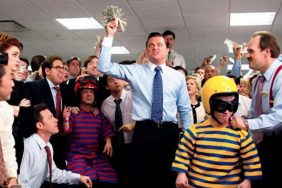Our last episode of The B-Movies Podcast here on CraveOnline (Episode #34, for the canonical completist) was kind of a blast, as William “Bibbs” Bibbiani and I, up too early, short on sleep and hopped up on donut sugar, reviewed not one, but five whole feature films for your delectation and intellectual stimulation. One of the films we reviewed was a largely unknown, straight-to-video sci-fi flick, produced by the Sci-Fi Channel (and despite its actual legal change, I still feel mawkish calling it “SyFy”) entitled 51, which was, to refresh your memory, a film about a group of reporters and army guys unexpectedly fighting off the alien monsters kept at Area 51. Both William and I felt that it was a solid bit of low-budget genre filmmaking that hit all of the right notes to keep old-school genre nuts like us satisfied.
Just like anything, there are right and wrong ways to make a “B” movie. I briefly pointed out a budget filmmaking irony on the show, and I will repeat what I said here, as I think it’s pertinent: Big-budget Hollywood genre blockbusters have enough time, money and connections to make films that are all action. They don’t need to do much padding, as they can afford to cut to the chase, write another chase into the script, and then cut to that one too. Lower-budget films, in contrast, may not have the money or resources to constantly stage action scenes, have explosions, or use state-of-the-art CGI to animate hordes of monsters. As a result, they have to spend a good deal of their allotted 90-120 minutes with dialogue scenes. The irony is that, through this need to add “padding,” the lower-budget films (at least those made by savvy filmmakers) focus on character development, witty dialogue, and interesting setups. What’s more, they may only have enough money for a single monster or maybe two, so a lot more love and care may go into the making and the filming of it. As a result, the low-budget films can be (and, in cases such as 51, often are) better than their mainstream Hollywood counterparts. I know I’d much rather see something like 51 again, than, say, Battle: Los Angeles.

In 1942, a producer named Val Lewton, and a director named Jacques Tourneur, made a low-budget horror/thriller called Cat People, starring a comely French actress named Simone Simon. The filmmakers, realizing that they were assigned a monster film, found themselves trying to design a convincing cat monster that could, if not rival, at least stand up to the awesomeness of the recent Wolf Man. After several tries, they realized that all they were getting were monsters that looked like guys in cheap cat suits. Rather than spend more money on more convincing cat makeup, they struck upon the idea that darkness is scarier than any old monster, and proceeded to film Cat People without any shots of the monsters, preferring to imply them using shadows and scary sound design. The result is one of the spookiest and creepiest films of the 1940s. They used their low budget to their advantage, and made a memorable monster that we didn’t even get to see. Necessity and his mother were hard at work.
There is a charm and a glory to the smaller, low-budget genre flicks that can never really be captured by the big-budget Hollywood status quo. And while there are scads and scads and scads of perfectly horrible “B” genre films in the world, most audiences may find themselves charmed and taken in by their earnestness, and actually involved on a deeper character level than they would be in a bigger film. There’s a sweetness to a practical horror film. When you see a filmmaker crushing a rubber human head filled with jelly, the effect is one of simultaneous horrific shock, and joyous recognition. We know what it feels like to work hard, and this guy did it, and it looks great.
Want some low-budget genre and monster films that are superior to anything with a $4 million CGI budget? Take a look at some of these straight-to-video beauties. N.B. These are not cheapo films that I adore for their failure (although I do have plenty of those). These do not fall into that treacherous chasm of “so bad they’re good,” whatever that means. These are all earnest films that succeeded on their own vast merits and limited resources:
PUPPET MASTER II (dir. Dave Allen, 1991)

Some of you may know about Full Moon Entertainment, and their once-powerful reign as straight-to-video horror’s undisputed king. These days, they are less prolific, and their output has skewed toward crass horror comedies (The Gingerdead Man, anyone?), but they were once well-known for their unending string of Puppet Master films, featuring a group of living marionettes who stalked about an old abandoned hotel, killing the rogues who dared to stay there. Even for 1991, the special effects in Puppet Master II were primitive, using a few shots of stop-motion animation, and a lot of clever puppetry to make the puppets themselves look alive. But you know what, a few bits of clever dialogue, a few nice kills, some gloriously gratuitous nudity, and some gross conceits (a formula made from human brains?) made this film way creepier than it had any right to be, and easily the best film of the Puppet Master series (and I’ll have you know, I’ve seen all 10 of them). What if Puppet Master II had more money? More time on set? Recognizable actors? Better effects? My guess is the impact would have been diminished.
PRIMER (dir. Shane Carruth, 2004)

This 2004 time-travel thriller, written and directed by first-timer Shane Carruth, was all brains. Two scientists discover that, using a certain kind of electrical current and computer program, can make time move more differently. If they make a box big enough to lay down inside of, they can essentially travel through time. This is a film that, rather than focusing on flash (which they could not have afforded), chose to wrestle with the implications of time travel, the practical uses, and the ethics. The dialogue is fraught with near-impenetrable shoptalk, speeches on ethics, and strange intentionally-specious doublebacks. Here is a film that deals directly with the paradoxes usually seen in time travel movies, and uses its mind to out-think them. It’s one of the smartest sci-fi films ever made, and one that could have only been achieved with a low budget.
THE BEACH PARTY AT THE THRESHOLD OF HELL (dirs. Jonny Gillette & Kevin Wheatley, 2006)

I managed to see this film on a big screen at the L.A. Film Festival back in 2006, and it only barely eked its way onto home video (oddly, under the Nation Lampoon aegis) two years later. This is a film that was so chock full of wacko ideas and low-budget gore effects, that it ended up worming its way into my brain, forcing me to think about it often. The story is beautifully absurd: It’s after the apocalypse, and the tough-talking, desert-dwelling descendant of JFK is attempting to lure the remaining human populace to emerge from their underground bomb shelters, and undo the tyranny of the wicked Castro descendant, and his army of immortal bikini teens. While this setup, in its description, sounds like a goofy spoof, the film is actually earnest and brutal, featuring a lot of gritty fights and depressing injuries. It’s one of the low-budget home-video jobs that, if enough people were to see it, it would become a legitimate cult hit. It was, to be fair, similar in tone and look to 1998’s well-beloved cult hit Six-String Samurai, but far more ambitious in its scope, and much more deserving of a rediscovery.
FROM THE DESK OF WILLIAM BIBBIANI:
Witney’s right, blah-blah-blah… Moving on now.
I have an unabashed love for the “SyFy Channel Original Movie” genre, which includes many films that weren’t actually shot for the decreasingly science fiction-based channel but play there anyway, usually on the weekends in lieu of repeats of Quantum Leap. I know a lot of people appreciate them ironically, and I suspect some producers of said films intentionally cater to that mindset (there’s no other explanation for Sharktopus), but the best ones have a sincerity that I admire. I like their earnestness, I like that they’re the final resting ground for the nearly dead “giant monster” genre (Remember the time Casper Van Dien fought a giant mummy? I do…), and I like that many of them are bad. I repeat: without irony. Here’s why.
I think there’s an intrinsic flaw with film studies, from an academic standpoint. When you go to film school you get a crash course in many of the best or at least most experimental movies ever made, from Last Year at Marienbad to Scorpio Rising. You can learn a lot from watching great movies, and if you’re interested in the medium from any standpoint owes it to yourself to see each and every one of them. But after you’ve seen them, then what? There’s a certain lack of intellectual engagement that comes from only watching “good” movies. The films themselves might engage you, but you can’t contribute much to their discussion beyond mere interpretation. Rashomon is nigh perfect? Great. Thanks for showing it to us. But if you’re making your own movie, you can’t just make Rashomon, or even riff off of it. You need to learn how make your own damned movie, and what’s the best way to learn? From your mistakes. But film is an expensive medium, so most of us can’t afford to fail time and time again before we start getting good at it (Uwe Boll being the exception). We should instead learn from other people’s mistakes, and as such I believe that studying bad movies, or at least flawed ones, should be a vital component of any film student’s education.

And so when I have the time, I like to mainline Sci-Fi Channel Original Movies. (Like Witney, I have trouble accepting the “SyFy” moniker.) Despite the occasional 51, which is a fine film on practically every level, the majority of movies in this sub-sub-genre are made by either fledgling filmmakers or old hands working with major budgetary and shooting constraints, and often less-than-stellar casts. It’s rare to find one that isn’t deeply flawed on some level, whether it’s the filmmakers’fault or not. And you and I can learn a lot about the craft from those limitations. For instance: often these productions can’t get the coverage (the individual and distinct shots that make up a scene) that they need, for time and budgetary reasons, so it’s usually easy to tell what shots they needed to sell a plot point but didn’t quite catch. As such, you learn what shots would be necessary were you to shoot something similar yourself, and a lot more easily than you would from watching a film that had the right coverage in the first place. You learn when inserts are needed, or what sort of dramatic moments most require close-ups in order to be properly emphasized, and so on. This “What Would I Do Differently”mindset can be illuminating if applied to any aspect of any flawed film, from editing to writing to musical scores and so on.
But I also watch Sci-Fi Channel Original Movies, and their Straight-to-Video, Grindhouse and 1950’s drive-in relatives, because every once in a while they’ll surprise you. There are some talented people making these things, and sometimes they overcome the limitations of their productions and whip out something genuinely entertaining, unusually engaging, or even legitimately good. I’d like to share a few of those movies with you, in the hopes that you will seek them out for yourself and start viewing the maligned sub-sub-genre with the same level of appreciation as Witney, myself, and anyone else with good taste in “bad”filmmaking.
ABOMINABLE (dir. Ryan Schifrin, 2006)

One of the most exciting discoveries in the world of Sci-Fi Original Movies came in the form of Abominable, a low budget yeti movie with a neat little twist. Everyone has heard about Bigfoot, but everyone who claims to have actually seen him is written off as a crackpot. Ryan Schifrin (son of the composing legend Lalo Schifrin, who wrote the original theme from Mission: Impossible and the score for Abominable as well, for perhaps obvious reasons) took that idea and wrapped it up in the plot from Rear Window, Alfred Hitchcock’s classic film about a peeping tom who thinks he’s seen a murder but can’t get anyone to believe him.
In Abominable, Matt McCoy plays a wheelchair-bound man who keeps seeing Sasquatch murder people, but, naturally, nobody takes him seriously. This plot device also allows Schifrin to make the most of his limited budget, since his protagonist can’t actively engage the beast for most of the film, limiting the monster’s screen time while maximizing its impact. The hero suffers from the same anxiety the audience does: wishing he could do more than just watch. A smart screenplay, a strong cast and eventually some really memorable monster effects make Abominable one of the very best Sci-Fi Original Movies ever made, and one of the most underrated horror films of the last ten years.
IT CONQUERED THE WORLD (dir. Roger Corman, 1956)

The Sci-Fi Channel Original Movie probably wouldn’t exist, at least in its current form, were it not for the influence of Roger Corman, who made a lot of films just like them in the 1950’s. Low budgets, cheesy monster effects, heavy padding and often-bad performances (even from otherwise great actors) were a staple of the early Corman efforts. But he typified the approach to genre filmmaking that Witney spent so much time describing. He couldn’t compete with the major Hollywood productions, so many of Corman’s films were overloaded with dialogue sequences, since actual action was more-or-less out of the question. It Conquered the World is no exception. This is, technically speaking, a “bad movie,” but it’s a bad movie with interesting ideas, and due in large part to its budgetary limitations focuses on a strikingly character-based plotline for a monster movie.
Lee Van Cleef (of The Good, The Bad and the Ugly fame) plays a scientist whose “crackpot” theories about alien life on Venus ruin his good name, so he allies himself with a conquering alien race that takes over the minds of the entire planet. But Van Cleef needs one of his peers, played by Peter Graves, to keep his mind intact so someone, at least, will be able to say that he was right. The monsters themselves define cheapness (they even inspired a Frank Zappa song called “Cheepnis”), but the real meat of the story lies in a compelling antagonist locked in a battle of wills with the hero. It Conquered the World sucks but it’s surprisingly inspired, and you can learn a lot from its achievements as well as its mistakes.
MEGA PYTHON VS. GATOROID (dir. Mary Lambert, 2011)

One of the more interesting Sci-Fi Channel Original Movie “successes,” Mega Python vs. Gatoroid got a fair amount of media attention, at least for this kind of release, because it co-starred 1980’s pop idols Debbie (“Only In My Dreams”) Gibson and Tiffany (“I Think We’re Alone Now”). It should have got more attention for actually being rather good, for what it is at any rate. The CGI effects are laughable, but the story is surprisingly strong. Debbie Gibson plays a radical environmentalist who liberates a whole bunch of pythons from a science lab and drops them in the Florida everglades, where they proceed to grow gigantic in size and threaten the already delicate eco-system. Tiffany plays a sheriff who tries to preserve the local alligator population by feeding them experimental steroids, thus giving them a fighting chance when they too grow into enormous monsters.
Debbie Gibson and Tiffany are incredibly game here, turning in fun performances and even partaking in a wonderful catfight in which Gibson makes a specific point of smearing cake on Tiffany’s ample cleavage. But beyond the casting gimmick and utter tawdriness, screenwriter Naomi L. Selfman crafts a strong storyline about two characters with diametrically opposed philosophies – neither one technically “wrong” – whose antagonistic relationship leads both women to sacrifice innocent lives in pursuit of what they think is right. Pet Cemetery director Mary Lambert can’t quite spin Mega Python vs. Gatoroid into gold, but strong conflict and a flare for camp turn earn her a silver medal at least.
WHAT ARE YOUR FAVORITE LOW-BUDGET MONSTER MOVIES, ANYWAY…?








